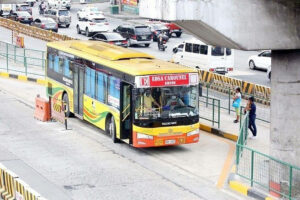THE Department of Transportation (DoTr) said on Monday that the Swedish government has offered to help expand the capacity of the EDSA Busway project, which suffers from long queues with demand currently overwhelming the available number of buses.
“Transportation Secretary Jaime J. Bautista gratefully received the offer of Swedish Ambassador to the Philippines Annika Thunborg to allow the government of Sweden to explore how to improve the EDSA Busway project,” the DoTr said in a statement.
“During a recent courtesy call at the DoTr Secretary’s office, Ambassador Thunborg relayed the Swedish government’s offer to help enhance the operational efficiency of the highly patronized EDSA Busway project, (which is currently offering) free rides to EDSA commuters until the end of the year,” it added.
The department said improving the EDSA Busway to accommodate the demand when face-to-face classes resume this month is in line with Mr. Bautista’s promise to raise the transport systems to global standards.
The EDSA Busway is a dedicated median bus lane service which is a joint initiative of the DoTr, Land Transportation Franchising Regulatory Board, Metro Manila Development Authority, and Department of Public Works and Highways.
In an appearance on ANC Headstart, Mr. Bautista said the department intends to “look for other possible bus stops” to improve the commuter experience.
“I had a meeting with the consortium that operates EDSA Carousel, and we asked them to have additional buses, especially during the start of the face-to-face classes on Aug. 22,” he added.
CABLE CARS
Mr. Bautista also said the department remains open to having cable cars in the National Capital Region (NCR) as a means of reducing traffic.
“I am not discounting the possibility of this. We are open to all ideas, although it might be difficult to implement it,” he said.
Last week, Senator Robinhood Ferdinand C. Padilla proposed the use of cable cars to decongest the roads.
“I would like to suggest it as it will be suitable for the Philippines, especially in Metro Manila, because of traffic,” he told Senators at a plenary session on Tuesday.
Mr. Bautista said following the proposal, “I asked our undersecretary for road sector to look at it.”
“We will conduct a study because for you to be able to implement a program, you need to have the important data,” he added.
The DoTr in the previous administration had endorsed a project proposal to the National Economic and Development Authority to build a cable car transit system between the Light Rail Transit (LRT) Line 2’s Santolan Station in Marikina City and Barangay Rosario in Pasig City.
The feasibility study for the Metro Manila urban cable car project was funded by the government of France.
The selected alignment spans 4.5 kilometers and mostly follows the Marikina River. It starts from LRT Line-2 Santolan Station and proceeds southward to Ortigas Avenue in Rosario, Pasig.
Four more sites for stations were identified between LRT-2 Santolan Station and Rosario: Quezon City’s Libis and Eastwood and Pasig City’s Santolan and Manggahan. — Arjay L. Balinbin
